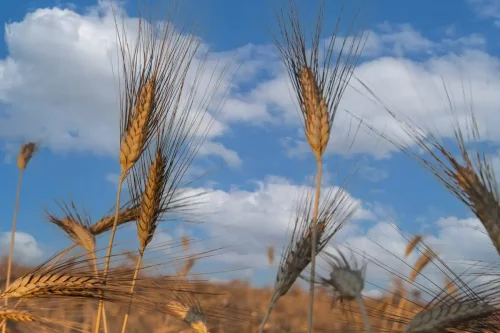Senatore Cappelli durum wheat is one of the most beloved and widespread wheat varieties in Italy, remaining authentic and unaltered since its birth in 1915. Today it is especially prized because of its nutritional characteristics unchanged over time, a particularly high protein intake and a rich, full-bodied flavor. But how did this highly prized cereal come into being?
The origins of durum wheat Cappelli
It all began in the early 1900s, when demand for wheat increased and new varieties began to be sought to improve yield and nutritional intake. In this climate, Marquis Raffaele Cappelli, a senator and promoter of the agrarian reform that led to the distinction between hard and soft grains, granted agronomist Nazareno Strampelli land near Foggia in which to carry out experimental sowing.
Strampelli had been engaged in the search for the perfect wheat for years and had already created new varieties of soft wheat by crossing different varieties from around the world. Continuing his research and moving on to hard grains to obtain more productive and disease-resistant ones, Strampelli arrived in 1915 at the creation of durum wheat to which he gave the name Senatore Cappelli. Born from a cross between a Tunisian variety, Jenah Rhetifah, and other wheat varieties, Senatore Cappelli durum wheat immediately demonstrated its qualities, so much so that in the 1930s and 1940s it was called a “chosen breed” and for decades was confirmed as the most widespread crop in Italy, especially in Basilicata and Puglia.
In later years, however, Cappelli wheat was in turn replaced by more productive plantations, often obtained through researcher-induced genetic mutations. Today, Senatore Cappelli durum wheat has become a niche product particularly used for fine and organic flours.
Strampelli had been engaged in the search for the perfect wheat for years and had already created new varieties of soft wheat by crossing different varieties from around the world. Continuing his research and moving on to hard grains to obtain more productive and disease-resistant ones, Strampelli arrived in 1915 at the creation of durum wheat to which he gave the name Senatore Cappelli. Born from a cross between a Tunisian variety, Jenah Rhetifah, and other wheat varieties, Senatore Cappelli durum wheat immediately demonstrated its qualities, so much so that in the 1930s and 1940s it was called a “chosen breed” and for decades was confirmed as the most widespread crop in Italy, especially in Basilicata and Puglia.
In later years, however, Cappelli wheat was in turn replaced by more productive plantations, often obtained through researcher-induced genetic mutations. Today, Senatore Cappelli durum wheat has become a niche product particularly used for fine and organic flours.
Characteristics and peculiarities
Senatore Cappelli durum wheat is easily recognizable: the plant can reach 180 cm, has the typical ariste (black filaments at the top of many grasses) and can only be grown organically because fertilization and herbicides would cause it to bend and break.
The presence of very deep roots allow this grain to resist weeds and draw nourishment from the deeper layers of the soil, those richest in nutrients.
The grains of Senatore Cappelli are particularly hard and make for a pasta that holds up particularly well to cooking while remaining al dente.
The presence of very deep roots allow this grain to resist weeds and draw nourishment from the deeper layers of the soil, those richest in nutrients.
The grains of Senatore Cappelli are particularly hard and make for a pasta that holds up particularly well to cooking while remaining al dente.
Nutritional properties
Prized for its intense and strong flavor, Senatore Cappelli durum wheat flour has very valuable nutritional properties, so much so that it has been called “the poor man's meat.” In fact, compared to modern grain flours, it contains higher percentages of proteins, amino acids, lipids, B vitamins, vitamin E and minerals.
It also has a very low level of gluten, which makes it easier to digest, and it has anti-inflammatory properties due to the presence of flavonoids and antioxidants that reduce intestinal problems and gluten intolerance. Finally, the amount of calories, which is slightly lower than that of other grains, helps keep cholesterol under control.
It also has a very low level of gluten, which makes it easier to digest, and it has anti-inflammatory properties due to the presence of flavonoids and antioxidants that reduce intestinal problems and gluten intolerance. Finally, the amount of calories, which is slightly lower than that of other grains, helps keep cholesterol under control.
Why choose an ancient grain?
Senatore Cappelli durum wheat, although just over 100 years old, is considered an ancient grain because it shares all its characteristics. In fact, ancient grains have remained authentic and original, not having undergone any modifications by man to increase their yield, just like Senatore Cappelli.
These grains are of higher quality than modern grains and should be preferred for several reasons:
Healthier and more wholesome products: because they have not undergone genetic rearrangements they maintain a lower yield and are not processed at intensive levels, ensuring more natural results
Stone-processed grains: ancient grains are usually stone-processed, producing less refined flours that retain all the nutritional characteristics of the grain
Less gluten: ancient grains maintain a balanced ratio of starch to gluten, resulting in more digestible grains and limiting the development of intolerances
More artisanal and less industrial products: ancient grains are usually cultivated and processed using artisanal methods, allowing the production chain to be kept track of and biodiversity to be protected
Better products: ancient grains, especially whole or semi-wheat, always have intense aromas and rich flavor that are lost during the industrial processing of modern grains
Choosing an ancient grain, and Senatore Cappelli durum wheat, therefore guarantees fine organic products that are rich in flavor and excellent for any processing.
These grains are of higher quality than modern grains and should be preferred for several reasons:
Healthier and more wholesome products: because they have not undergone genetic rearrangements they maintain a lower yield and are not processed at intensive levels, ensuring more natural results
Stone-processed grains: ancient grains are usually stone-processed, producing less refined flours that retain all the nutritional characteristics of the grain
Less gluten: ancient grains maintain a balanced ratio of starch to gluten, resulting in more digestible grains and limiting the development of intolerances
More artisanal and less industrial products: ancient grains are usually cultivated and processed using artisanal methods, allowing the production chain to be kept track of and biodiversity to be protected
Better products: ancient grains, especially whole or semi-wheat, always have intense aromas and rich flavor that are lost during the industrial processing of modern grains
Choosing an ancient grain, and Senatore Cappelli durum wheat, therefore guarantees fine organic products that are rich in flavor and excellent for any processing.

